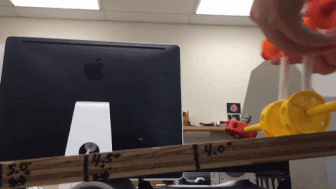Walking – we all do it. But why do we walk so often? Why doesn’t everyone skip down the block to work?

Aside from that being deemed as weird by society, walking is the most efficient way for people to move on earth due the gravity here. We’ve all experienced this in some way. You probably know that it’s much easier to walk long distances, than to run them. In my Clare Boothe Luce work this year, I confirmed that walking is amazingly efficient by simulating a passive walker that is able to walk down a hill simply through the force of gravity.
My Junior IS study “Building a Passive Robot for Active Learning,” aimed to take this simulation research and create a real passive walking robot (a robot without a motor) out of plastic Tinkertoys. I used a previous study done by a group at Cornell to base my walker design off of and to use as a comparison. When they built their robot in the 1990s, wooden Tinkertoys were mass-produced, but now plastic Tinkertoys are the only financially possible option. I found that the walkers behaved slightly differently due to sensitivity to initial conditions and parameters for passive walkers. Though this difference exists, I proved that it is still possible to create this simple passive walking robot.
The hope is that this walker could be used as an outreach tool at Science Days at the College of Wooster in order to introduce kids to engineering and to make mechanics a more approachable topic to them. This project is a fun way to spark children’s imaginations and learn more about how fascinatingly efficient human movement can be.

